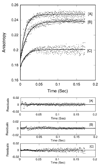Kinetic analysis of the interaction of b/HLH/Z transcription factors Myc, Max, and Mad with cognate DNA
- PMID: 20170194
- PMCID: PMC2852888
- DOI: 10.1021/bi901913a
Kinetic analysis of the interaction of b/HLH/Z transcription factors Myc, Max, and Mad with cognate DNA
Abstract
Myc, Mad, and Max proteins belong to the basic helix-loop-helix leucine zipper family of transcription factors. They bind to a specific hexanucleotide element of DNA, the E-box (CACGTG). To be biologically active, Myc and Mad require dimerization with Max. For the route of complex assembly of these dimers, there are two proposed pathways. In the monomer pathway, two monomers bind DNA sequentially and assemble their dimerization interface while bound to DNA. In the dimer pathway, two monomers form a dimer first prior to association with DNA. The monomer pathway is kinetically favored. In this report, stopped-flow polarization was utilized to determine the rates and temperature dependence of all of the individual steps for both assembly pathways. Myc.Max dimerization had a rate constant approximately 5- and approximately 2-fold higher than those of Max.Max and Mad.Max dimerization, respectively. The protein dimerization rates as well as the dimer-DNA rates were found to be independent of concentration, suggesting conformational changes were rate-limiting. The Arrhenius activation energies for the dimerization of Myc, Mad, and Max with Max were 20.4 +/- 0.8, 29 +/- 0.6, and 40 +/- 0.2 kJ/mol, respectively. Further, rate constants for Max.Max homodimer DNA binding are significantly higher than for Myc.Max and Mad.Max heterodimers binding to DNA. Monomer-DNA binding showed a faster rate than dimer-DNA binding. These studies show the rate-limiting step for the dimer pathway is the formation of protein dimers, and this reaction is slower than formation of protein dimers on the DNA interface, kinetically favoring the monomer pathway.
Figures








Similar articles
-
Thermodynamics of protein-protein interactions of cMyc, Max, and Mad: effect of polyions on protein dimerization.Biochemistry. 2006 Feb 21;45(7):2333-8. doi: 10.1021/bi0522551. Biochemistry. 2006. PMID: 16475822 Free PMC article.
-
Assembly of b/HLH/z proteins c-Myc, Max, and Mad1 with cognate DNA: importance of protein-protein and protein-DNA interactions.Biochemistry. 2005 Sep 6;44(35):11855-63. doi: 10.1021/bi050206i. Biochemistry. 2005. PMID: 16128587 Free PMC article.
-
X-ray structures of Myc-Max and Mad-Max recognizing DNA. Molecular bases of regulation by proto-oncogenic transcription factors.Cell. 2003 Jan 24;112(2):193-205. doi: 10.1016/s0092-8674(02)01284-9. Cell. 2003. PMID: 12553908
-
Structural aspects of interactions within the Myc/Max/Mad network.Curr Top Microbiol Immunol. 2006;302:123-43. doi: 10.1007/3-540-32952-8_5. Curr Top Microbiol Immunol. 2006. PMID: 16620027 Review.
-
The Max transcription factor network: involvement of Mad in differentiation and an approach to identification of target genes.Cold Spring Harb Symp Quant Biol. 1994;59:109-16. doi: 10.1101/sqb.1994.059.01.014. Cold Spring Harb Symp Quant Biol. 1994. PMID: 7587059 Review.
Cited by
-
Mutations to transcription factor MAX allosterically increase DNA selectivity by altering folding and binding pathways.Nat Commun. 2025 Jan 14;16(1):636. doi: 10.1038/s41467-024-55672-2. Nat Commun. 2025. PMID: 39805837 Free PMC article.
-
Hyperpolarized water as universal sensitivity booster in biomolecular NMR.Nat Protoc. 2022 Jul;17(7):1621-1657. doi: 10.1038/s41596-022-00693-8. Epub 2022 May 11. Nat Protoc. 2022. PMID: 35546640 Free PMC article. Review.
-
NMR-identification of the interaction between BRCA1 and the intrinsically disordered monomer of the Myc-associated factor X.Protein Sci. 2024 Jan;33(1):e4849. doi: 10.1002/pro.4849. Protein Sci. 2024. PMID: 38037490 Free PMC article.
-
Transcriptional amplification in tumor cells with elevated c-Myc.Cell. 2012 Sep 28;151(1):56-67. doi: 10.1016/j.cell.2012.08.026. Cell. 2012. PMID: 23021215 Free PMC article.
-
Associating transcription factors and conserved RNA structures with gene regulation in the human brain.Sci Rep. 2017 Jul 18;7(1):5776. doi: 10.1038/s41598-017-06200-4. Sci Rep. 2017. PMID: 28720872 Free PMC article.
References
-
- Gearhart J, Pashos EE, Prasad MK. Pluripotency redux-advances in stem-cell research. N Engl J Med. 2007;357:1469–1472. - PubMed
-
- MacGregor DN, Ziff EB. Proteins of the Myc network: essential regulators of cell growth and differentiation. Pediatr Res. 1990;28:63–68. - PubMed
-
- Henriksson M, Luscher B. Regulation of cyclin D2 gene expression by the Myc/Max/Mad network: Myc-dependent TRRAP recruitment and histone acetylation at the cyclin D2 promoter. Adv Cancer Res. 1996;68:109–182. - PubMed
Publication types
MeSH terms
Substances
Grants and funding
LinkOut - more resources
Full Text Sources

